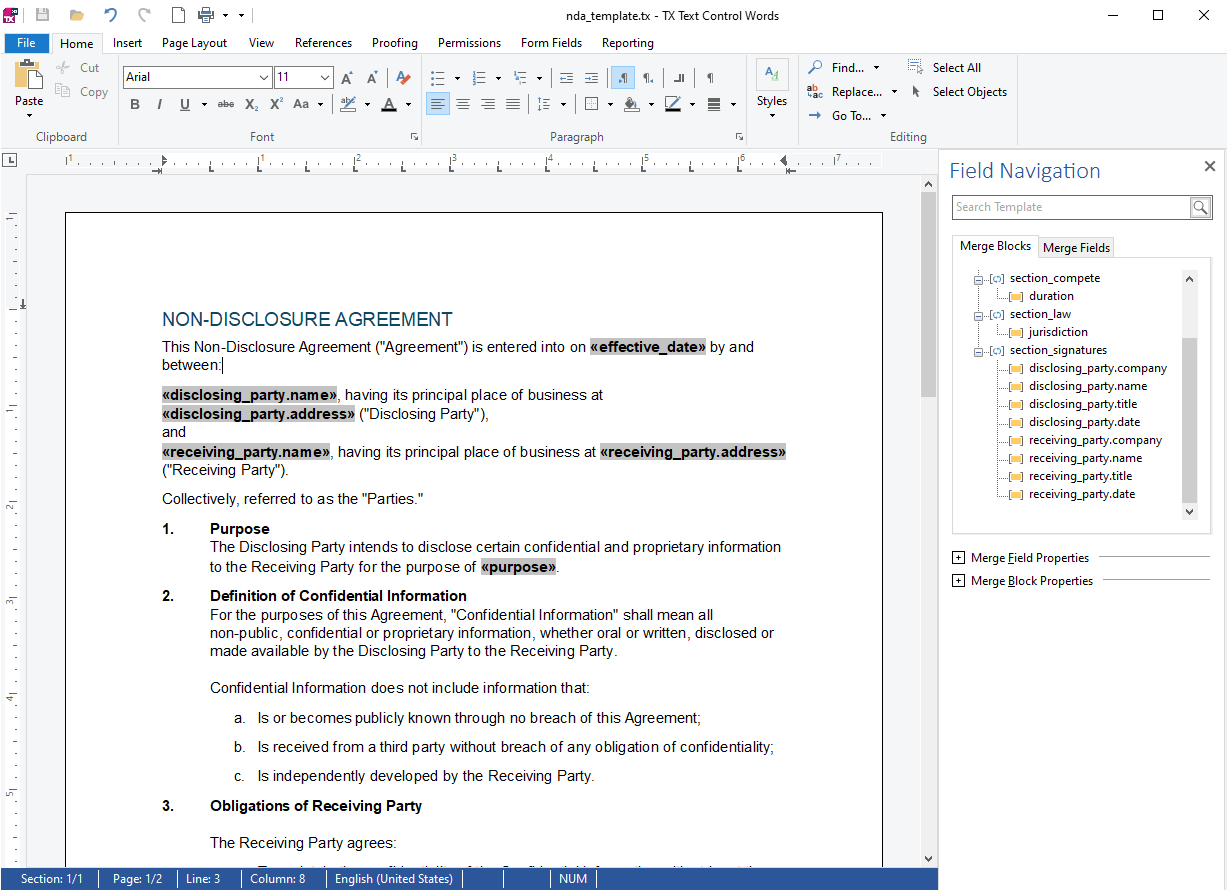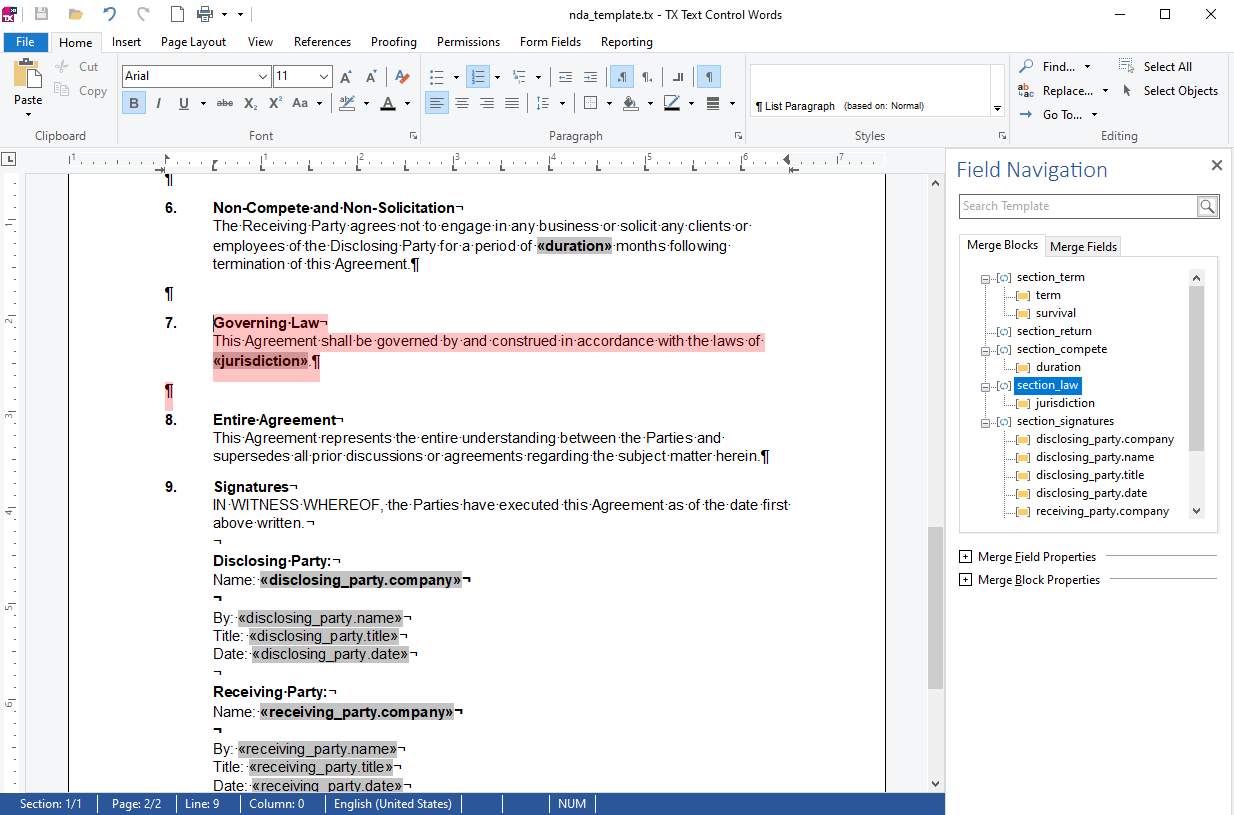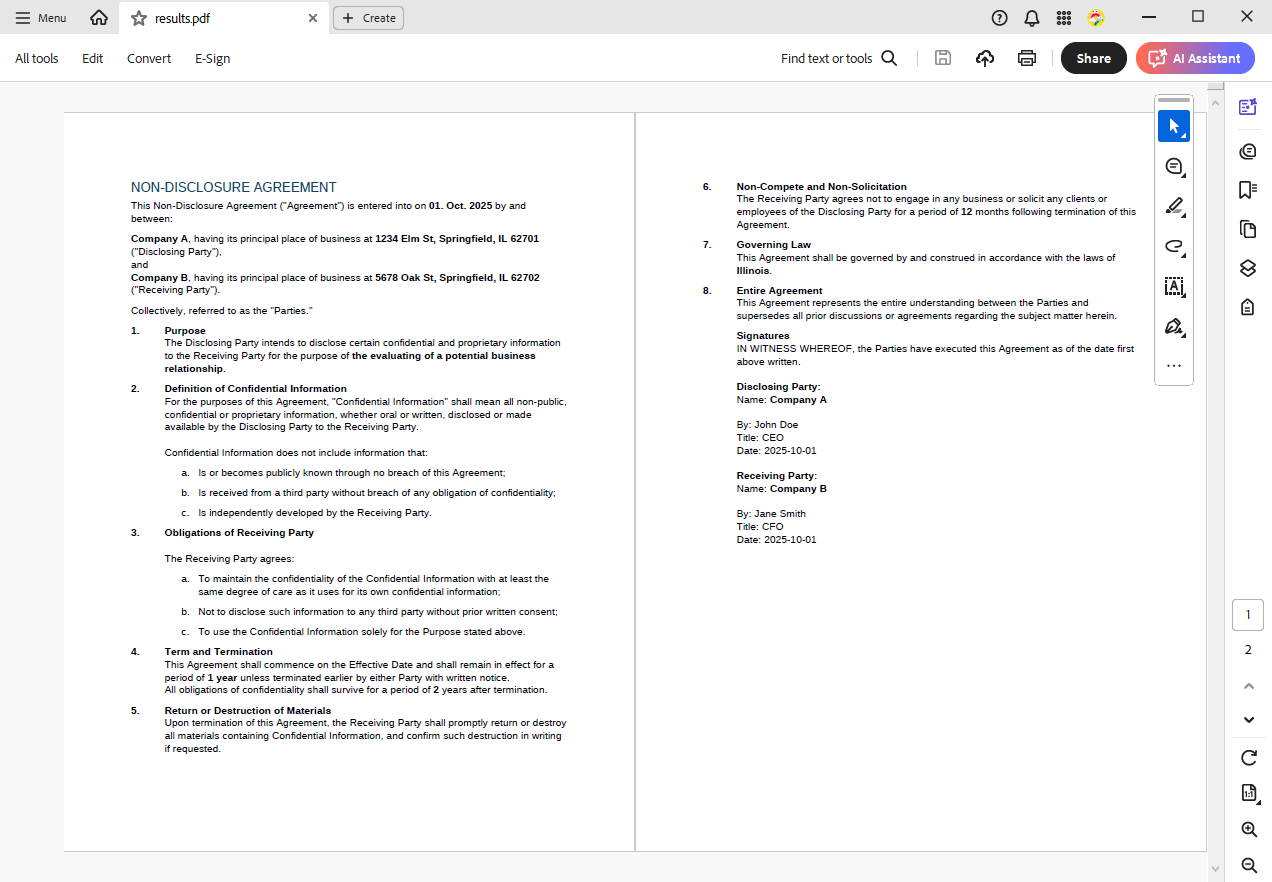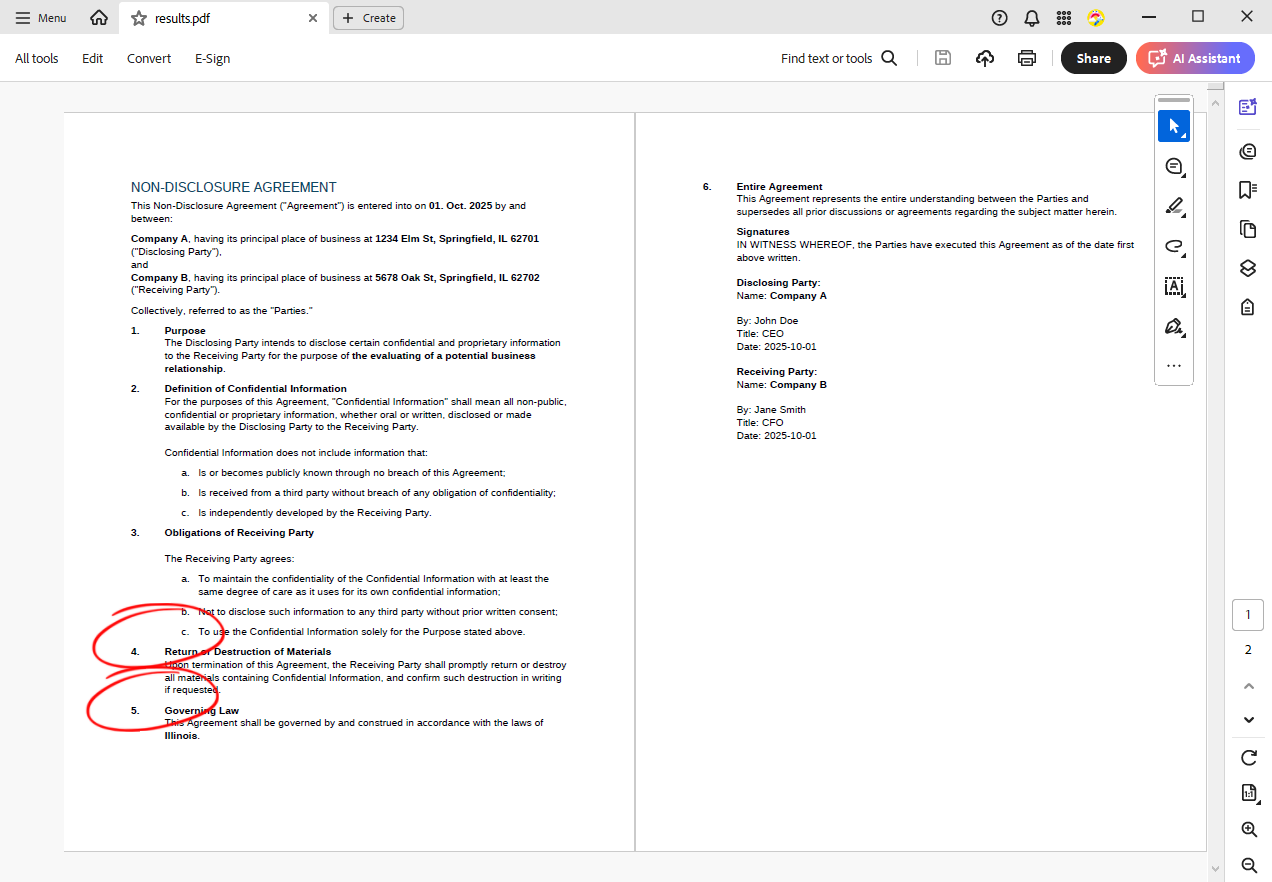Generating Dynamic NDAs Using TX Text Control MailMerge in C# .NET
This article demonstrates how to generate dynamic NDAs using TX Text Control MailMerge in C# .NET. It covers the process of creating a template, binding data, and generating the final document.

Dynamic contracts are a critical part of many data-driven applications. One of the most common examples is the non-disclosure agreement (NDA). While the structure of NDAs is fairly consistent, the content often needs to vary based on the business case, such as jurisdiction, clauses, or duration.
In this article, we'll show you how to build a dynamic NDA generator using TX Text Control's Mail
Dynamic, Data-Driven Contracts
The goal of this concept is to have a template with merge fields for dynamic data and also the ability to include specific sections in the agreement that are optional. With TX Text Control, you can create a single template that includes all possible sections and let the data itself control what is rendered. Hardcoding each variation would be inefficient and error-prone.
Here's a breakdown of a typical NDA and the sections that can be dynamically controlled using merge fields or conditional blocks:
| Section | Dynamic? | Merge Fields / Conditions |
|---|---|---|
| Introduction / Preamble | No | «effective_date» «disclosing_party.name» «disclosing_party.address» «receiving_party.name» «receiving_party.address» |
| Purpose | No | «purpose» |
| Definition of Confidential Information | No | |
| Obligations of Receiving Party | No | |
| Term and Termination | Yes | «term» «survival» |
| Return or Destruction of Materials | Yes | |
| Non-Compete and Non-Solicitation | Yes | «duration» |
| Governing Law | Yes | «jurisdiction» |
| Entire Agreement | No | |
| Signatures | Yes | «disclosing_party.company «disclosing_party.name» «disclosing_party.title» «disclosing_party.date» «receiving_party.company» «receiving_party.name» «receiving_party.title» «receiving_party.date» |
Creating the Template
The first part of the template looks very straightforward, with structured numbered lists and merge fields as placeholders where the actual data will be merged.

Now let us look at the dynamic part of the contract template. The dynamic sections consist of merge blocks (highlighted in red by default) with optional merge fields.

Using Merge Blocks
Pay close attention to what is in the merge block. It includes the last carriage return line feed and an extra carriage return character, which is necessary because we may be removing content from a numbered list. So in both cases, whether the content remains or is removed, the list is perfectly intact.

Using the MailMerge Engine
For demonstration purposes, we will use the following JSON data as our sample data for the merge process. This JSON data contains all the data needed to include all the sections.
[
{
"effective_date": "2025-10-01",
"disclosing_party": {
"name": "Company A",
"address": "1234 Elm St, Springfield, IL 62701"
},
"receiving_party": {
"name": "Company B",
"address": "5678 Oak St, Springfield, IL 62702"
},
"purpose": "the evaluating of a potential business relationship",
"section_return": {},
"section_compete": {
"duration": 12
},
"section_law": {
"jurisdiction": "Illinois"
},
"section_signatures": {
"disclosing_party": {
"company": "Company A",
"name": "John Doe",
"title": "CEO",
"date": "2025-10-01"
},
"receiving_party": {
"company": "Company B",
"name": "Jane Smith",
"title": "CFO",
"date": "2025-10-01"
}
}
}
]The following code is required to merge the JSON data into the template using the Mail
using TXTextControl.DocumentServer;
using TXTextControl;
using ServerTextControl tx = new();
// Create a new document instance in memory
tx.Create();
// Load NDA template (TX Text Control format)
tx.Load("Data/nda_template.tx", StreamType.InternalUnicodeFormat);
// Load JSON data for MailMerge from file
string jsonData = File.ReadAllText("Data/nda_data.json");
// Initialize MailMerge with the document
MailMerge mailMerge = new()
{
TextComponent = tx,
RemoveEmptyBlocks = true, // Removes blocks that remain empty after merge
};
// Track merged block names
List<string> blockNames = new();
mailMerge.BlockMerging += (sender, e) =>
{
blockNames.Add(e.BlockName);
};
// Merge JSON data into the loaded template
mailMerge.MergeJsonData(jsonData);
// Export the filled NDA to a PDF file
tx.Save("results.pdf", StreamType.AdobePDF);
// Output result to console
Console.WriteLine(blockNames.Count > 0
? $"Merged {blockNames.Count} blocks: {string.Join(", ", blockNames)}"
: "No blocks were merged.");If you use the full JSON with all sections, the output should be this and a PDF is generated.
Merged 5 blocks: section_signatures, section_law, section_compete, section_return, section_termIn the created PDF you can see that all merge fields are filled and all sections are included.

Removing Sections
Now let's remove the section_term and section_compete sections from the JSON and merge it back together. The JSON now looks like this:
[
{
"effective_date": "2025-10-01",
"disclosing_party": {
"name": "Company A",
"address": "1234 Elm St, Springfield, IL 62701"
},
"receiving_party": {
"name": "Company B",
"address": "5678 Oak St, Springfield, IL 62702"
},
"purpose": "the evaluating of a potential business relationship",
"section_return": {},
"section_law": {
"jurisdiction": "Illinois"
},
"section_signatures": {
"disclosing_party": {
"company": "Company A",
"name": "John Doe",
"title": "CEO",
"date": "2025-10-01"
},
"receiving_party": {
"company": "Company B",
"name": "Jane Smith",
"title": "CFO",
"date": "2025-10-01"
}
}
}
]And the output is this:
Merged 3 blocks: section_signatures, section_law, section_returnAs you can see, the sections are removed from the PDF and the list is still intact.

The result is a perfectly designed contract that is completely dynamic and 100% controlled by the data.
Benefits of This Approach
This approach allows you to create a single template that can handle multiple variations of a contract. This reduces the need for multiple templates and simplifies the contract creation process. It also allows for easy updates to the template without having to modify multiple files.
- Reusability: One template covers hundreds of NDA variations.
- Accuracy: Reduces manual errors by automating document assembly.
- Efficiency: Generate a polished, branded NDA in seconds.
- Flexibility: Easily update legal language across all generated NDAs.
Conclusion
In summary, using TX Text Control's MailMerge engine with dynamic merge blocks allows you to create flexible and efficient contracts that can adapt to different business needs. This not only saves time, but also ensures that your contracts are always up to date and compliant with the latest legal standards.
The sample code and templates provided in this article can be used as a starting point for your own NDA generator. Feel free to modify the template and JSON data to suit your specific requirements.
![]()
Download and Fork This Sample on GitHub
We proudly host our sample code on github.com/TextControl.
Please fork and contribute.
Requirements for this sample
- TX Text Control .NET Server 33.0
- Visual Studio 2022
ASP.NET
Integrate document processing into your applications to create documents such as PDFs and MS Word documents, including client-side document editing, viewing, and electronic signatures.
- Angular
- Blazor
- React
- JavaScript
- ASP.NET MVC, ASP.NET Core, and WebForms
Related Posts
Designing the Perfect Contract Template for MailMerge in C#
This article shows how to create a contract template for MailMerge in C# using the TX Text Control .NET Server component. It uses JSON data to merge the template with the data including table of…
Filtering and Sorting Repeating Blocks in MailMerge using C#
TX Text Control MailMerge's ability to filter and sort repeating merge blocks is a key strength, making it ideal for creating dynamic reports, lists, and catalogs.
Use MailMerge in .NET on Linux to Generate Pixel-Perfect PDFs from DOCX…
This article explores how to use the TX Text Control MailMerge feature in .NET applications on Linux to generate pixel-perfect PDFs from DOCX templates. This powerful combination enables…
Designing a Maintainable PDF Generation Web API in ASP.NET Core (Linux) C#…
This article shows how to create a PDF generation Web API in ASP.NET Core on Linux using TX Text Control .NET Server. The clean architecture is used to create a maintainable and testable solution.
Manipulating Table Cells During the MailMerge Process in .NET C#
This article shows how to manipulate table cells during the mail merge process in .NET C#. The FieldMerged event can be used to manipulate the table cells after they are merged.






